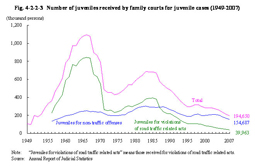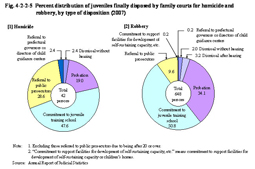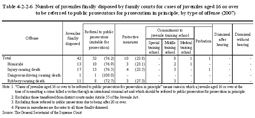| Previous Next Index Image Index Year Selection | |
|
|
2 Juvenile hearing Fig. 4-2-2-3 shows the trends in the number of juvenile offenders newly received by family courts since 1949. The number of juvenile offenders received for non-traffic offenses hit a peak in 1966 and 1983, and then it was on a declining trend for a while. In recent years it had been flat at around 200,000 juveniles, but the number decreased for four consecutive years from 2004. The number of juvenile offenders received for violations of road traffic related acts declined sharply after the traffic violation notification system came to be applied to juveniles in 1970 and the range of application of the system was expanded in 1987, and has been on a declining trend ever since. Fig. 4-2-2-3 Number of juveniles received by family courts for juvenile cases (1949–2007) (2) Disposition of juvenile casesa. Outline of final disposition Fig. 4-2-2-4 shows the percent distribution of juveniles finally disposed for [1] non-traffic offenses excluding pre-delinquency and negligence in the pursuit of social activities, etc. (referring to negligence in vehicle driving/negligence in the pursuit of social activities and dangerous driving causing death or injury; hereinafter the same in this section), [2] negligence in the pursuit of social activities, etc., and [3] violations of road traffic related acts in 2007, by type of disposition. Fig. 4-2-2-4 Percent distribution of juveniles finally disposed by family courts, by type of disposition (2007) b. Disposition for homicide and robberyFig. 4-2-2-5 shows the percent distribution of juvenile cases finally disposed by family courts for homicide and robbery by type of disposition (see Appendix 4-10 for the number of juveniles finally disposed by family courts by type of offense). Fig. 4-2-2-5 Percent distribution of juveniles finally disposed by family courts for homicide and robbery, by type of disposition (2007) c. Referral to public prosecutors for prosecutionTable 4-2-2-6 shows the number of juveniles finally disposed by family courts in 2007 for cases where juveniles aged 16 or over killed victims through an intentional criminal act and that should be referred to public prosecutors for prosecution in principle (excluding those referred to public prosecutors due to being age 20 or over; hereinafter the same in this subsection), by type of offense. The total number of juveniles in those cases to be referred to public prosecutors for prosecution in principle since April 1, 2001 was 422 (excluding 13 juveniles who were referred to public prosecutors and then transferred from district courts under Article 55 of the Juvenile Act back to family courts), amongst whom 263 (62.3%) were decided to be referred to the public prosecutor. All of the 13 juveniles mentioned above (10 juveniles for injury causing death, two juveniles for robbery causing death, and one juvenile for homicide) who were transferred from district courts to family courts were committed to juvenile training schools (Source: The General Secretariat of the Supreme Court). Table 4-2-2-6 Number of juveniles finally disposed by family courts for cases of juveniles aged 16 or over to be referred to public prosecutors for prosecution in principle, by type of offense (2007) |



